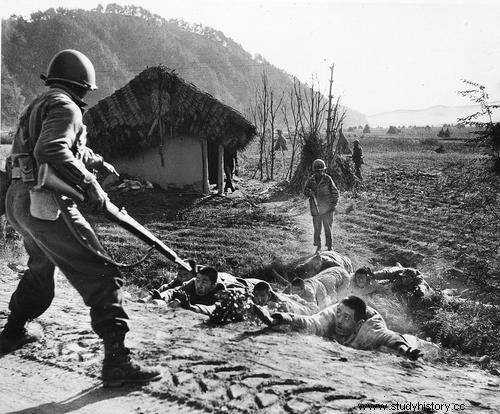
The method, which soon came to be given the evocative name of the 'drum hammer', involved a ruthless ramming of enemy positions on the hills. It began with long-range artillery fire, from a distance of more than 15 km. Then the barrage came closer and closer, using shorter-range light artillery, tank guns and infantry rifles, machine guns and mortars from dug-in dugouts.
The first reconnaissance during the third week of January revealed that the Chinese had been led to stop at Wonju, in central Korea, and that to the west, near Inchon, there were no important concentrations. of Chinese troops near United Nations lines. As a result, the first of the limited-objective attacks, dubbed Operation Thunderbolt, began on January 25.
It was primarily intended to inflict maximum casualties and gain ground:it was was to go to the Han River. On February 2, Operation Punch, a secondary one, was directed against Hill 440 north of Suwon. 4,200 of them were killed.
On February 10, "Thunderbolt" enabled United Nations forces to reach Han, retake Inchon and neutralize Seoul.
The operation. “Roundup” which followed on February 5, was aimed at advancing UN lines in Central Korea. The struggle to achieve this objective was particularly fierce.
The Chinese crushed 3 South Korean divisions north of Hoengson and broke through the UN lines. Around Chipyong-ni, 30 km west of Hoengson, units of a French battalion and a regiment of the US 2nd Division were surrounded for 3 days.
A bit Further east, the right flank of 10th Corps was threatened for some time when North Korean troops arrived near Chechon. This communist counter-offensive was resolute but lacked momentum. It ended after six days.
Operation "Killer" began on February 21:the objective was to seize the road that joined the sea to the east, from Wonju to Kangnung; in 9 days, the Chinese front, south of the Han River, was collapsing. Thus, after 5 weeks, on March 1, the United Nations lines were fixed at positions 45 km south of the 38° parallel, from Kimpo in the west to around Kangnung in the east.
The regular but laborious advance was nothing spectacular:it had made it possible to gain 80 km in the west, 20 km in the center and 45 km in the east. However, the United Nations forces had proven superior to the Chinese armies; and they were to maintain this superiority throughout the rest of the Korean War. Moreover, the discouraging image of the Chinese superman was beginning to fade.
On March 7, Operation Ripper, led by United Nations forces, affected eastern and central Korea. Using the same military methods as before, Ripper reconquered Seoul on March 14–15; on March 31, a new front line called "Idaho" was established, the advanced point of which in the center was less than 15 km from the 38th parallel.
During the month of April, which saw the controversial removal of General MacArthur, the steamroller of United Nations forces once again moved northwest. Operation "Rugged", which began on April 5, led them to cross the 38' parallel and establish themselves on the "Kansas" line in 9 days. On April 19, an offshoot, the "Utah" line, was held by the Americans of the 1st and 29th Corps. On April 21, the 1st United Nations front stretched from Munsan-ni in the west to the east coast just north of Taepo-ri.
Through the positions they occupied, these forces seriously threatened what was known as the "Iron Triangle", a fortified area where Chinese troops were supplied and regrouped and whose summit was located near Pyongyang, and the base between Chorwon in the west and Kumhwa in the east. Fearing for the vital center of their resistance in Korea, the Chinese resumed the offensive more violently than they had ever done.
In the nearly six weeks since the fall of Seoul, on March 14 and 15, the Chinese had shown themselves to be less combative:they now seemed to prefer retreat. Later, in April, it appeared that this was a strategic choice.
The Chinese had indeed learned from their enemies the value of a strategic withdrawal. They had also borrowed from them the technique of weakening the adversary with artillery bombardments before attacking him.
For 4 hours during the day of April 22, an intense artillery preparation descended on the positions of the United Nations. Then, when the moon rose, the first of the 475,000 Communist fighters, massed in and around the "Iron Triangle", engaged in the first phase of the Chinese Spring Offensive. The United Nations now faced the most vigorous Chinese military effort of the Korean War, backed by belligerent declarations from Beijing and Pyongyang, proclaiming that the enemy would be annihilated and Seoul would be offered to Joseph Stalin—who then led the Soviet Union — on the occasion of May Day.
For several days, one could believe that these declarations were founded. By dawn on April 23, Chinese troops, advancing with the support of mortars and machine guns, had crossed the Imjin River and taken the road from Chorwon to Seoul further south. But the United Nations front resisted, except in the center where a South Korean division was partially destroyed. The breach was, however, closed. The Chinese, however, continued their advance. On April 23, the American troops had to retreat as well as the South Koreans who were pushed back south of the road to Seoul.
